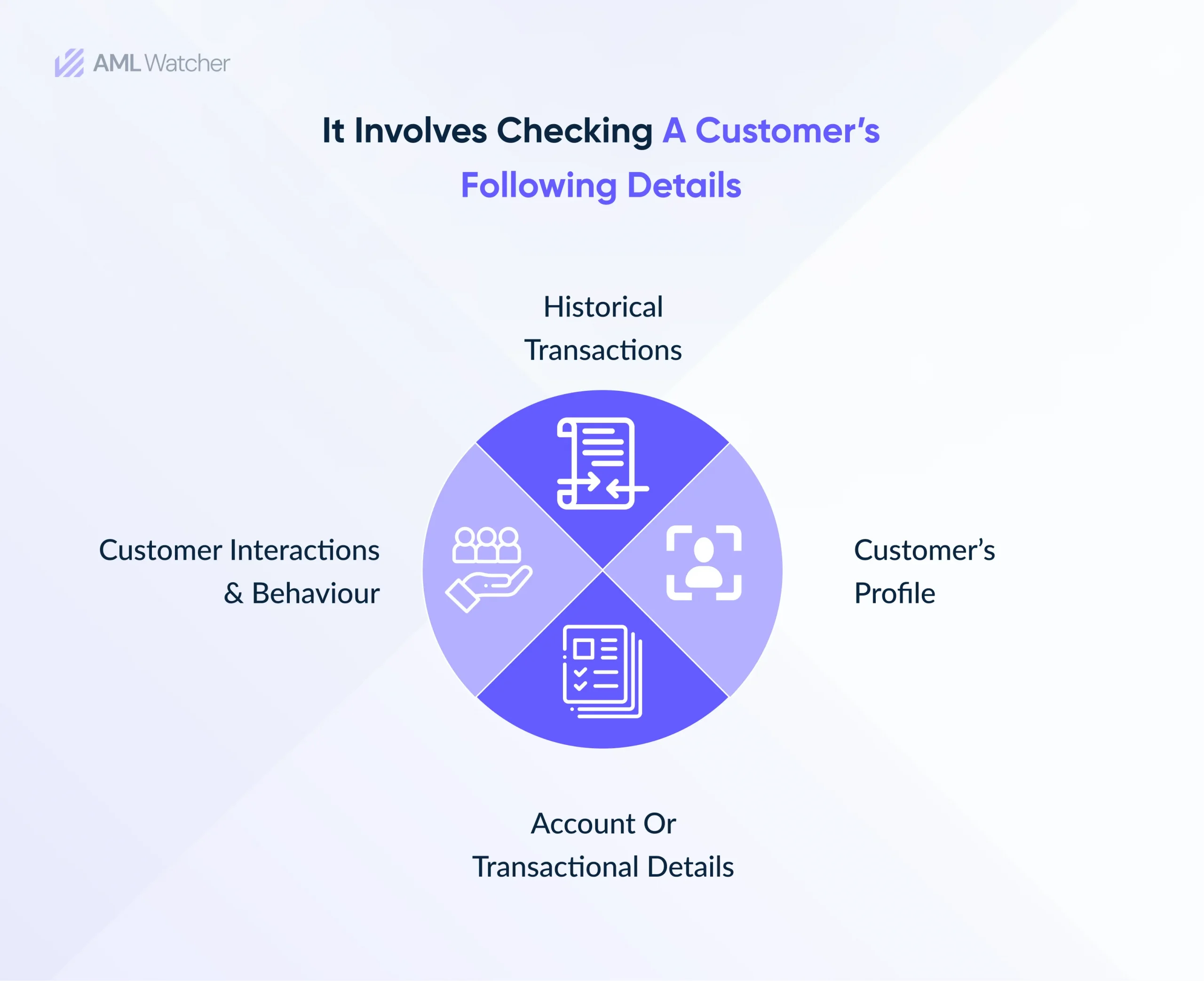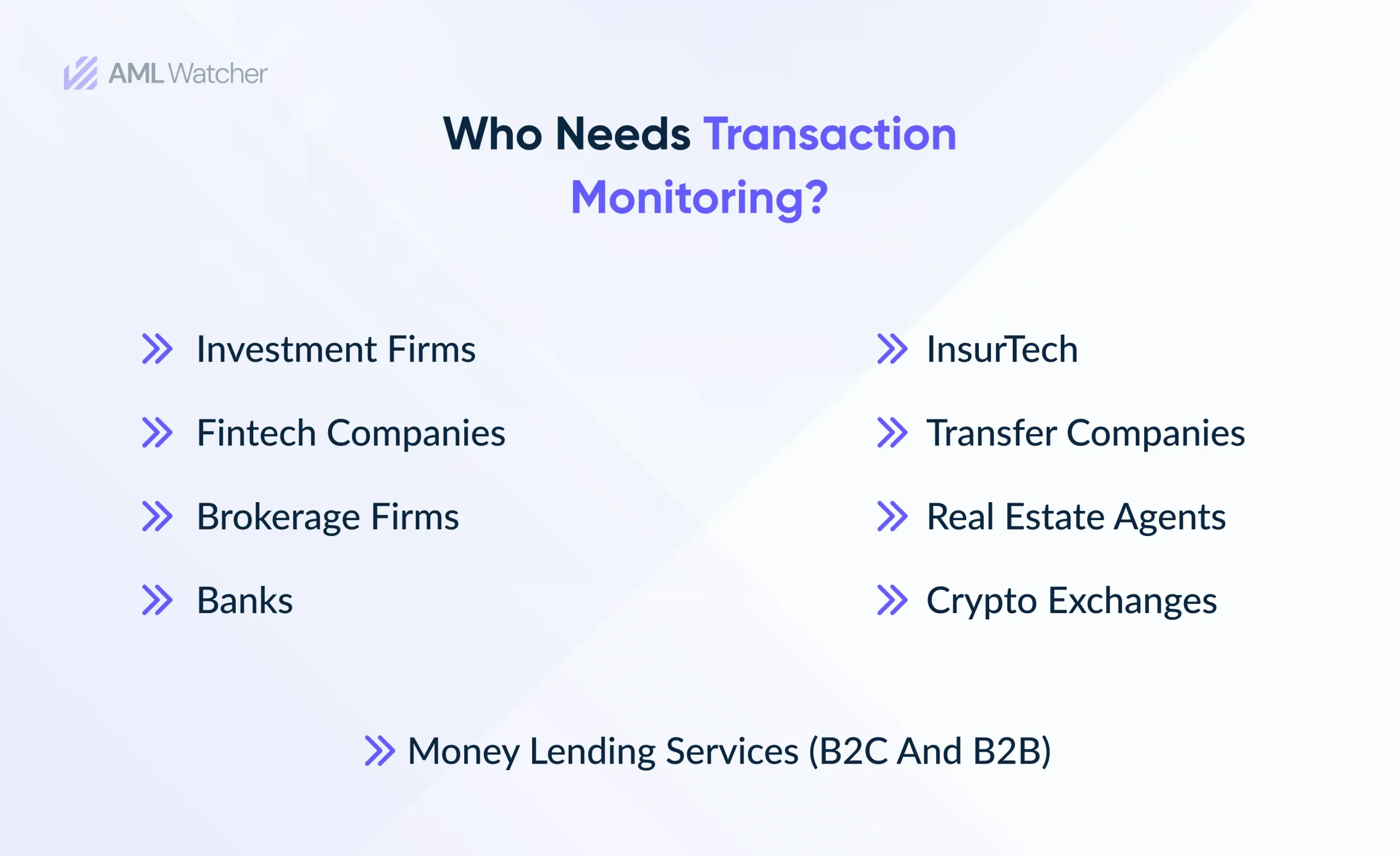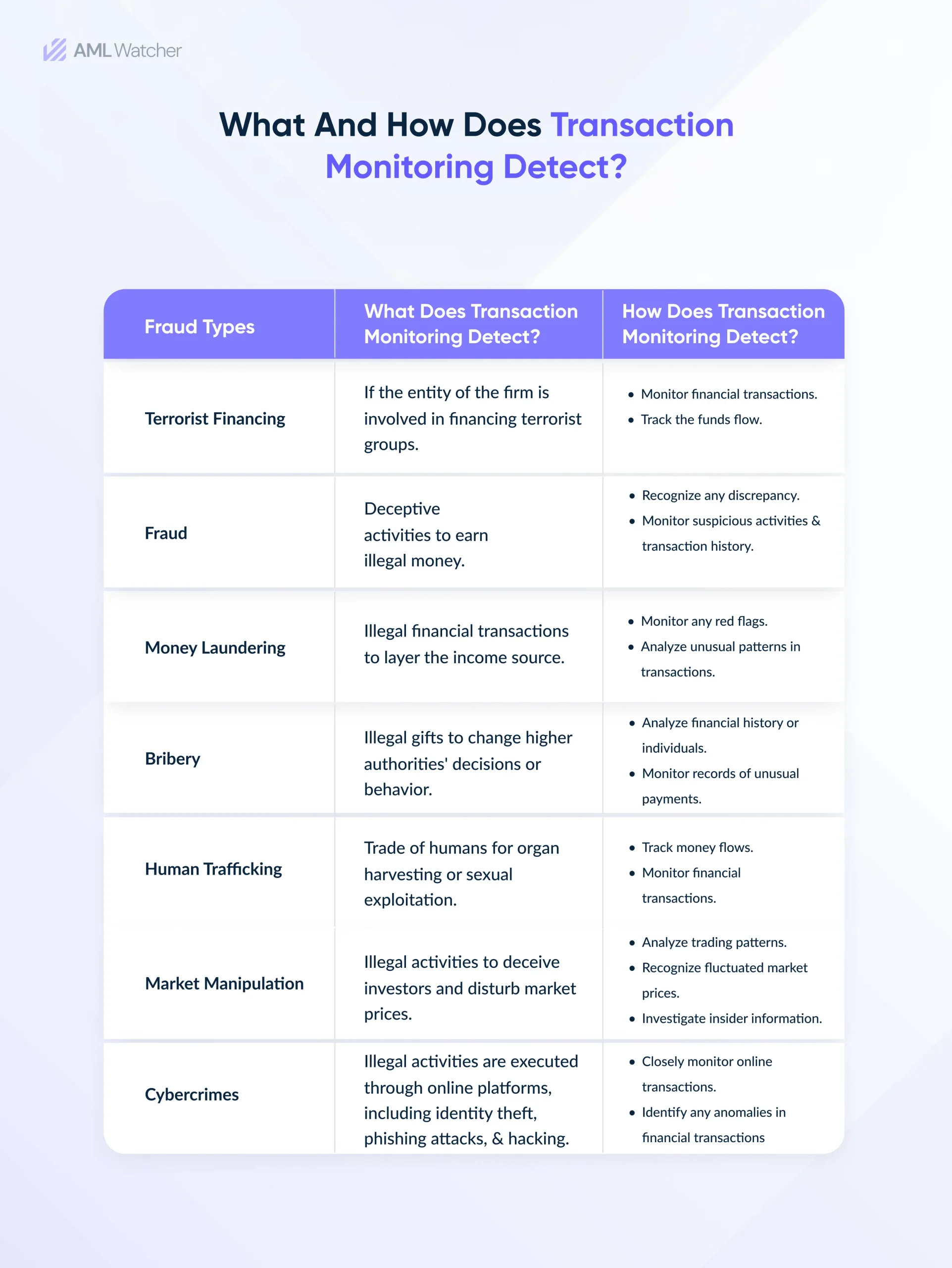
A Complete Guide to Transaction Monitoring in 2025
According to a survey in 2023, 31% of adults in the U.S. found themselves as a victim of financial cybercrime, while the remaining 69% never encountered any online financial fraud. In this scenario, banks have a regulatory requirement and societal responsibility to reduce the rising risk of financial scams.
Scammers are using advanced techniques to breach the safety measures of financial institutions, so organizations have to mitigate this risk by monitoring client activity through transaction monitoring. Just like in 2021, different organizations paid AML fines; they could have avoided them by complying with transaction monitoring, which we will be discussing in this blog.
Let’s get into this blog post to understand every aspect of transaction monitoring.
What is Transaction Monitoring?

Banks are considered to be one of the most regulated entities that continuously review the account holder’s activities.
In case any suspicious transaction is observed, then the financial institutions, including banks, take the required actions to investigate the transaction with the account owner.
For example, a high-value financial transaction that the account owner had never done.
This complete process comes under transaction monitoring, which tracks the financial transactions to detect anomalies, and timely detection of any scan can save firms from damage.
Therefore, it’s considered an essential anti-money laundering measure (AML).
So, any firm or entity that is under AML regulations and constantly dealing with financial transactions should implement transaction monitoring.
Why does Transaction Monitoring Matter?
Transaction monitoring actively does retrospective and ongoing client monitoring to understand anomalies or suspicious financial transactions.
10 recommendations of FATF push financial firms to undergo transactions during business relationships as its primary goal is to ensure that banking transactions are aligned with the client’s history, including their source of funds.
Governments are cracking down on firms that aren’t actively imposing AML regulations to prevent money laundering. They aren’t only heavily fined but also deal with the negative consequences of not imposing rules.
Transaction monitoring system demands the following questions:
- Origin of Funds
- Is it a legitimate receiver?
- Where is the amount going?
- Any suspicious activities or anomalies in the financial transaction
The following are several reasons why transaction monitoring solutions are essential:
Reduce Financial Crimes
Transaction Screening detects and prevents money laundering, which usually involves the source of money that is illegally obtained. After thoroughly analyzing transactional data, financial firms quickly detect suspicious activities, including wire transfer scams and credit card fraud.
Ensure Regulatory Compliance
Transaction monitoring is an essential component of AML CFT compliance, so financial firms should implement an accurate monitoring system to comply with laws, including market manipulation and insider trading.
Improve Risk Management
Transaction monitoring program helps firms to recognize vulnerabilities and emerging risks in any financial institution by taking proactive measures to address potential risks. By doing so, banks and other financial firms improve their risk management capabilities.
Transaction Monitoring Process
As transaction monitoring is rising in the digital world, its revenue is expected to reach $17.59 billion by 2024 at a CAGR of 9.4%. Many financial firms understand the importance of transaction monitoring systems, so let’s explore their different components to understand better.
Data Collection
Transaction monitoring systems should collect complete information from different sources, including external databases, payment systems and client accounts. Collected data of customers should have their names, locations, dates, and transactional amount. Select the system with integrated data from diverse sources that provide a complete overview of customer financial activities.
Data Analysis
Transaction monitoring systems should clean the gathered data to ensure consistency and accuracy. For this purpose, data mining techniques are used to recognize suspicious patterns in a financial transaction.
Rule Engines
Rule engines create and manage rules that clearly define anomalies. Thereby, rules have to depend upon patterns and thresholds. Transaction monitoring systems evaluate financial transactions against pre-determined rules to recognize matches.
Reporting
Afterward, if a financial transaction matches with any suspicious activity, the transaction monitoring system sends a warning. That should depend upon the severity of any risk. Then, with the passage of time, the system has to provide tools for generating dashboards and reports to analyze anomalies.
Case Management
Case management features investigate suspicious activity alerts and facilitate collusion between diverse teams in any firm. Therefore, the transaction monitoring system provides different tools for making decisions and documenting investigations.
These steps are essential to secure clients and comply with regulatory requirements.
Types of Transaction Monitoring Systems
Transaction monitoring proved to be essential in identifying anomalies to prevent fraud. The following are its major types:
Rule-Based Monitoring
It’s impossible for compliance officers to review each financial transaction because they are huge in number. Transaction monitoring uses pre-defined regulations and benchmarks to identify transactions that seem suspicious.
This is relatively simple to understand and manage as compared to the traditional way.
Rule-based transaction monitoring alerts firms if any rule violation occurs, and then the compliance officer can easily detect whether or not the transaction is suspicious.
Machine Learning Based Monitoring (MLBM)
MLBM is an advanced technique that transforms traditional transaction monitoring procedures. MLBM predicts potential issues, provides proactive insights, and optimizes system performance.
Large datasets can be analyzed by implementing advanced algorithms with the passage of time, and it can identify suspicious activities that can’t be recognized through a rule-based system. This type is more adaptive to dynamic fraud patterns because it can manage massive data volume in one go.
Statistical Monitoring
Statistical monitoring tracks and analyzes essential data with the passage of time to recognize anomalies, suspicious patterns, and recent trends that are significant problems. This includes the statistical methods to assess if discovered changes are important or if there is any fluctuation.
Network Monitoring
Network monitoring is a complete procedure in which AML software observes and analyzes network traffic within financial firms to resolve performance issues, prevent security threats, and make a bridge in giving unauthorized access to scammers.
Capturing, logging, and investigating network packets to recognize any suspicious activity and anomalies are the primary objectives of this technique.
Behavior Transaction Monitoring
Behavioral aml transaction monitoring software is a process that recognizes any anomalies in financial transactions by thoroughly analyzing the behavior of customers or entities. This process goes beyond rule-based monitoring by understanding the historical customer data and context of financial transactions. Behavioral transaction techniques quickly detect fraud and other illegal activities.
Real-Time Transaction Monitoring
Real-time transaction monitoring continuously monitors and analyzes financial transactions at the time they occur, which helps in instant detection and response to any suspicious activity.
This process is used to quickly identify any suspicious activity in financial transactions that allows entities and financial institutions, specifically banks, to take immediate action.
What is Synthetic Transaction Monitoring?
Synthetic transaction monitoring or “web transaction monitoring” is the process of artificially generated financial transactions to impersonate clients’ real-time financial activities.
However, they are generated under controlled conditions that will allow for precise testing and evaluation of different systems, specifically transaction monitoring systems.
Web transaction monitoring = Monitoring consumer experience
Basically, through synthetic transaction monitoring, firms can explore their website or app by pretending to be actual users.
In this way, entities can explore their log-ins and critical areas to be improved from the user end and visit dashboards.
Why Should Firms Use Synthetic Monitoring?
According to Northern Arizona University, 88% of online customers will not return after any bad experience. Synthetic transaction monitoring provides the following real-time benefits:
Improve Benchmark
Synthetic monitoring enables firms to use historical data to improve their business decisions as it will set a benchmark to understand overall performance and provide real-time insights.
Quickly Fix Problems
This technique warns the IT team if any suspicious activity occurs, including a lack of financial transaction data and low traffic at the site. That’s how developers can fix the actual problem.
Track Complicated Financial Transactions
Firms can determine if people can easily do transactions or if their app is correctly working by artificially making purchases, filling out forms, and, lastly, adding things to a cart.
Observe Peak Traffic Seasons
Synthetic transaction monitoring accurately mimics client behaviors from different regions to analyze web applications, APIs, and mobile apps closely. This process helps identify different geographic areas and potential peak markets.
Overall, synthetic transactions are essential to ensure the effectiveness and reliability of the transaction monitoring system. Let’s explore why transaction monitoring is essential for banks.
Transaction Monitoring in Banks
Bank Transaction monitoring monitors the overall financial activities of customers to see any signs of money laundering and any other financial fraud.
This process helps banks in understanding the behavior of their customers. For example, at what time does the XYZ client withdraw and transfer funds? To which he or she sends and how much.
Transaction monitoring satisfies compliance requirements as it allows firms to secure from criminal activities by exposing why clients are sending huge amounts of money to someone.
After facing a £63,946,800 fine from the Financial Conduct Authority (FCA), HSBC made a decision to implement a transaction monitoring system that uses machine learning algorithms and advanced analytics to identify suspicious activities and unusual patterns.
What is AML Transaction Monitoring?
Anti-money laundering transaction monitoring detects and ceases money laundering activities by thoroughly analyzing the financial transaction behavior of clients.
Regional Breakdown of AML Transaction Monitoring
In the U.S., AML transaction monitoring rules are regulated by the USA Patriot Act and Bank Secrecy Act (BSA). These regulations require financial firms to implement AML programs to avoid money laundering activities.
The famous regulatory agency, Financial Crimes Enforcement Network (FinCEN), is solely responsible for issuing guidance to assist firms in implementing AML regulations.
Requirements under US anti-money laundering regulations are:
- Enforcing risk-based AML programs.
- Conducting customer due diligence (CDD).
- Maintaining timely records of customer financial transactions.
- Filing suspicious activity reports (SARs).
Requirements under EU anti-money laundering regulations are:
- The national competent authorities, including the Financial Conduct Authority (FCA) and European Banking Authority (EBA), monitor the enforcement of AML rules in EU member states.
- Firms have to conduct CDD, ongoing monitoring of financial transactions, and risk assessment to prevent suspicious activities.
- Virtual asset and payment service providers or financial firms should comply and be subjected to EU AML regulations.
- In the EU, AML transaction monitoring is governed by the 5th and 6th AML directives (5AMLD and 6AMLD).
- The regulations force firms to report anomalies and suspicious activities to Financial Intelligence Units (FIUs) to promote secure transactional data.
Frequently Asked Questions
What is Transaction Monitoring?
Transaction monitoring analyzes financial transactions of entities or individuals to identify and prevent money laundering and fraud.
What is Transaction Monitoring in AML?
Transaction monitoring in AML continuously reviews and analyzes financial transactions to recognize any suspicious activities that are specifically linked to money laundering scheme.
What is the Transaction Monitoring Process?
Transaction monitoring process is a systematic technique to analyze and review financial transactions to recognize suspicious activities and other illegal activities, including:
- Data Collection
- Data Analysis
- Rule-Based Monitoring
- Case Management
- Reporting
What is a Transaction Monitoring System?
A transaction monitoring system is software specifically designed to review and monitor financial activities to recognize any anomalies and financial transactions that are linked with money laundering.
What is Synthetic Transaction Monitoring?
Synthetic transaction monitoring is a technique that is used to analyze the reliability and performance of transaction processing systems by mimicking actual transactions. This process is used to improve apps or software by analyzing what customers face daily.
What is Transaction Monitoring in Banking?
Transaction monitoring in banking involves the continuous analysis and review of financial transactions to recognize suspicious activities that are linked with money laundering.
Why is Transaction Monitoring Important?
Transaction monitoring is essential for different reasons, including:
- Detecting and preventing financial crimes
- Ensuring regulatory compliance
- Mitigating financial risks
- Securing clients
- Improving business reputation
- Improving risk management
AML Watcher – A Shield Against Money Laundering
Transaction monitoring is an essential aspect of AML compliance. AML Watcher is providing fraud prevention tools so that firms can secure themselves by complying with them.
Stay alert to any emerging threats and compliance issues. Our AML database will help you screen profiles at the global level to investigate the exact nature of their business.
Contact us to get more comprehensive information about AML sanction screening solutions that will give you accurate results for your queries about Sanctions and PEP.
Book Free DemoWe are here to consult you
Switch to AML Watcher today and reduce your current AML cost by 50% - no questions asked.
- Find right product and pricing for your business
- Get your current solution provider audit & minimise your changeover risk
- Gain expert insights with quick response time to your queries





